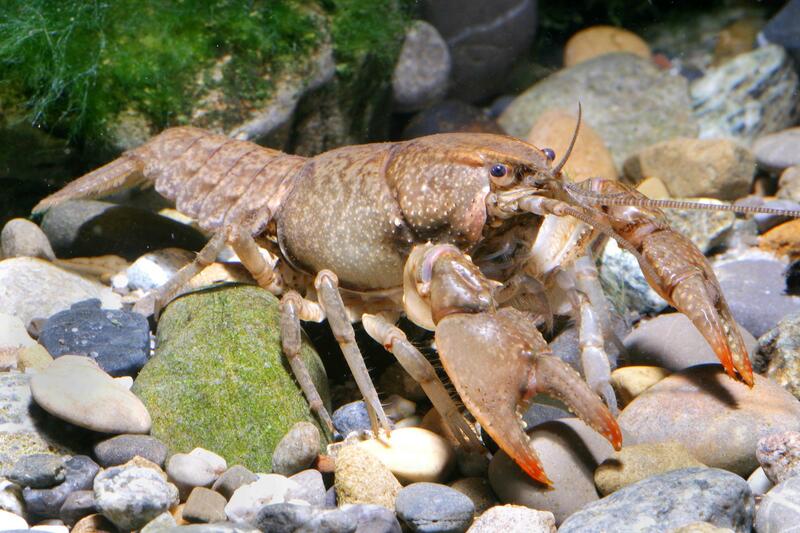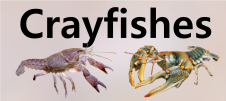







Loading profile. Please wait . . .
Cambarus latimanus (Le Conte, 1856)
Variable Crayfish




Federal Protection: No US federal protection
State Protection: No Georgia state protection
Global Rank: G5
State Rank: S5
Element Locations Tracked in Biotics: No
SWAP 2015 Species of Greatest Conservation Need (SGCN): No
SWAP 2025 Species of Greatest Conservation Need (SGCN): No
2025 SGCN Priority Tier: None
Element Occurrences (EOs) in Georgia: 0
Habitat Summary for element in Georgia: Associated with rocks or woody deb
The overall color of the Variable Crayfish is light brown to olive with darker mottling. Occasionally the darker pigmentation is so dense on the abdomen that the animal has a striped appearance. The tips of the claws are usually orangish and there are two rows of tubercles along the mesial margin of the palm. The areola is fairly narrow but never obliterated. The rostrum typically tapers, but occasionally has marginal tubercles (even spine-like in juveniles). A single cervical tubercle is usually present and may be a sharp spine on juveniles. This species reaches a maximum total body length of about 75 mm (3 in).
Across its range, the Variable Crayfish is most similar to the Ambiguous Crayfish, Cambarus striatus. According to Hobbs (1981) the two are sometimes impossible to separate. The areola of the Ambiguous Crayfish is typically narrower and rostrum typically shorter than that of the Variable Crayfish. The Common Crayfish, Cambarus bartonii, is a relatively plain looking brownish species with darker mottling but usually has a wider areola and a single row of flattened tubercles on the mesial margin of the palm.
The Variable Crayfish is considered a secondary burrower and thus is found in open water of flowing streams as well as burrow complexes along the banks of streams. Within a stream this species is found hiding beneath rocks, within woody debris and leaf litter, and beneath undercut banks.
Boyce (1969) found that Variable Crayfish are similar to other species by being opportunistic omnivores and likely feed on live and decaying vegetation, aquatic insect larvae, small fishes, and dead animal matter.
Stream dwelling crayfishes typically hide during the day and come out at night to feed. Reproduction usually occurs during the spring and fall, but males in reproductive condition may be found at any time during the year. When female secondary burrowers are ready to lay eggs, they likely retreat to burrows and hence are rarely encountered. When the eggs are released, the female attaches them to her swimmerets and is said to be “in berry.” Upon hatching, the juvenile crayfish are attached to the mother by a thread. After the juveniles molt for the second time, they are free of the mother, but stay close and will hold on to her for some time. Eventually they move off on their own. Crayfishes molt 6 or 7 times during their first year of life and most are probably able to reproduce by the end of that year. They molt once or twice a year for the remainder of their lives and live about 3 years. Male Variable Crayfish in reproductive condition have been collected in all months except February, July, and August. Three females carrying eggs were found in April (Bouchard 1978). The smallest male from Georgia is about 64 mm (2.5 in). The largest female specimen collected is about 90 mm (3.5 in) in length (Hobbs 1981).
Flipping larger rocks in just about any habitat in a stream should turn up this species. The animal can be pinned by hand or gently driven into a dipnet. Shocking downstream into a seine net with a backpack electroshocker may also be effective. Excavating burrows along banks may also yield specimens.
The Variable Crayfish is one of the most common and widespread species in Georgia. It is most commonly found in the Piedmont physiographic province and is found in all major river systems there. It is absent from the Tennessee River drainage in the northwestern portion of the state and the Little Tennessee River system. The species penetrates the Coastal Plain in all of the major river systems, but largely disappears in the lower one-third of the state. This species is also known from Alabama, Florida, North Carolina, South Carolina, and Tennessee.
Heavy sedimentation resulting from poor development and land management practices may cover substrates and other daytime hiding places on which crayfishes rely to avoid predation. The introduction of non-native crayfishes is a threat to all native crayfishes.
This species is widespread and common and apparently stable in Georgia.
General watershed level protection measures will help secure the continued existence of the Variable Crayfish in Georgia. These include the protection of riparian zones, control of sediment and nutrient runoff from farms and construction sites, and limiting the amount of impervious cover (e.g., pavement) within occupied watersheds. Non-native crayfishes should never be used for bait. Instead, anglers should use crayfishes collected from the river system they will be fishing in and should never release unused bait crayfish back into Georgia waters.
Bouchard, R.W. 1978. Taxonomy, ecology, and phylogeny of the subgenus Depressicambarus, with the description of a new species from Florida and redescriptions of Cambarus graysoni, Cambarus latimanus, and Cambarus striatus (Decapoda: Cambaridae). Alabama Museum of Natural History Bulletin 3:26–60.
Boyce, J.L. 1969. An Ecological Study of Cambarus latimanus (LeConte) and Procambarus spiculifer (LeConte) in the Yellow River of the Altamaha River Basin of Georgia, with Particular Emphasis on Respiration and Tolerance to Low Oxygen. Master’s Thesis. Emory University, Decatur, GA. 105 pp.
Hobbs, H.H., Jr. 1981. The crayfishes of Georgia. Smithsonian Contributions to Zoology 318:1–549.
Hobbs, H.H., Jr. 1989. An illustrated checklist of the American crayfishes (Decapoda: Astacidae, Cambaridae, and Parastacidae). Smithsonian Contributions to Zoology 480:1–236.
Taylor, C.A., G.A. Schuster, J.E. Cooper, R.J. DiStefano, A.G. Eversole, P. Hamr, H.H. Hobbs III, H.W. Robison, C.E. Skelton, and R.F. Thoma. 2007. A reassessment of the conservation status of crayfishes of the United States and Canada after 10+ years of increased awareness. Fisheries 32:372–389.
Christopher E. Skelton
C. Skelton, 2012: original account
C. Skelton, February 2019: general update of account.